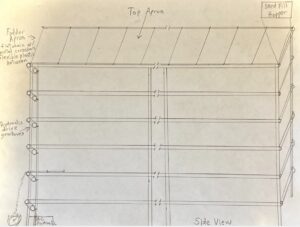Project Overview
Commodities
Practices
Proposal summary:
Several SARE projects have
researched the nutritional effectiveness of feeding sprouted
winter cereals to livestock, including a major university study
by Utah State that is ongoing. Many of these have demonstrated
comparable or improved animal performance on BSF with significant
sustainable benefits but the labor involved with current systems
has proved costly or too much for a one family farm to
consistently handle. A common thread of the research can be
summed up by the authors of FNC 12-881: “Although the system yields a very effective
product, the labor was difficult for us to maintain throughout
the week. With more efficiencies the labor might be reduced but
the requirement of daily inputs would still
remain.”
Currently, both Harry Cope and
Josh Payne have produced 1000 lbs per day of BSF with a hand
harvested hydroponic system for the past two years, daily
producing BSF to be fed on pasture to meat producing livestock
(primarily sheep and cattle), and have experienced the daily
grind of fodder production. While there are fully automated
systems on the marketplace, they are expensive, require major
infrastructure investments, and highly specialized, which would
make it hard for farmers to be able to repair on their
own.
Project objectives from proposal:
Harry Cope and Josh Payne have
conceptually designed a fully automated hydroponic grow system
that should reduce labor, and therefore BSF production costs,
significantly. The new system is designed by farmers, for farmers
using readily available parts and technology with which farmers
have experience. It can be installed either in an existing
building or placed in a used refrigerated semi-trailer, so it can
be portable, and even leasable, thus making this sustainable feed
source available to producers large and small alike.
Essentially, the design involves
a multi-level manure spreader apron buil with existing apron chains and drive systems available
with existing apron chains and drive systems available
from a major manufacturer. The frame will be constructed out of
aluminum by a local machine shop and designed to fit in a used
refrigerator trailer, which is readily available nationwide due
to the shipping industry. Seed will be automatically
dispersed using a renovated grain drill seed box and spread using
the electric / hydraulic driven manure spreader apron. Harry and
Josh will use their existing lighting and water distribution
systems, along with a pool sand filter and a mounted plastic
water tank, to clean and recycle water on site, further reducing
water needs. Solar panels can be included at a later date to
further enhance the sustainability of the project.
On day six of the grow cycle, a
switch will be triggered to engage the desired manure spreader
apron, and the BSF will be rolled out of the system into a highly
customizable chute which can be adapted to fit the equipment of
pretty much any farm. This machine should allow the producer to
produce up to 2000 lbs of BSF per day while drastically reducing
labor costs.
Since multiple SARE grants have
tested the nutritional viability, we will primarily focus our
research on the labor saving components of this project. Once the
machine is running, we will do multiple quality control BSF
forage analyses through Dairy One to ensure consistency
with previous trials, but this will be a sub-section of research.
Instead, we will continue running our existing, manual systems
and research labor inputs per lb of BSF to provide a baseline
cost. This includes handling seed in a variety of ways farmers
might experience it - 50 lb cleaned sacks and bulk tote bags
(appx 2000 lbs), spreading seed, daily washing trays to prevent
mold, and carrying trays to dump in a feed delivery
method.
Once the machine is constructed,
we will chart the same time requirements using the automated
system, both for the machine and the human running the machine,
thus providing a meaningful comparison to the hand harvest system
already in place.
Objectives:
-
-
Maintain hand-harvest
production of BSF -
Construct automated BSF
production machine -
Evaluate the benefit of
this machine to the farm. -
Evaluate the daily costs of
feeding livestock with this machine. -
Share findings via a field
day/demonstrations.
-
Maintain hand-harvest